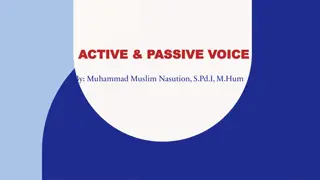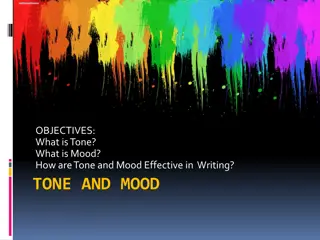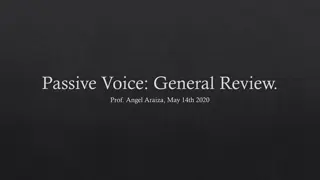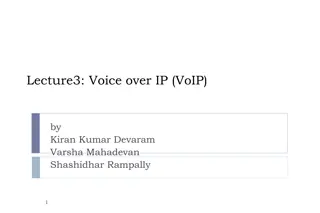Understanding Intonation and Tone in Phonetics
Intonation and tone play crucial roles in conveying meaning and expression in spoken language. Intonation refers to the melodic pattern of speech that can indicate various emotions or grammatical functions, while tone represents the pitch, quality, and strength of vocal sounds within words. By maste
4 views • 27 slides
Principle and Methodology for dRU Tone Plan Design in IEEE 802.11-20
Introduction of Distributed Tone RU (dRU) as a potential UHR PHY feature to address PSD limitations for 6GHz LPI and enhance Rate vs. Range performance. Emphasis on dRU tone plan design criteria, methodologies, and performance simulations. Detailed examination of design principles, methods, consider
4 views • 23 slides
Understanding Active and Passive Voice Usage
Learn about the differences between active and passive voice in English grammar, how to convert sentences from active to passive voice, and examples of active and passive voice usage in different tenses. Understand which verbs can be used in passive voice constructions and practice changing sentence
9 views • 7 slides
Embracing Your Voice in Academic Writing
Academic writing doesn't require you to abandon your unique voice. It's about finding a balance between everyday language and academic tone. Avoiding convoluted writing is key to engaging readers. Blending colloquial and academic styles can enhance clarity and audience understanding, making complex
1 views • 19 slides
Understanding the Concept of Voice in Literature
Voice in literature refers to the unique personality imparted by an author onto their work, defining how narrators convey stories. This piece explores the definition, types, functions, and roles of voice in literary works, focusing on the author's voice, character's voice, and the interaction betwee
2 views • 11 slides
Understanding Passive Voice in English Grammar
Explore the concept of passive voice in English grammar through examples and explanations. Learn how to identify passive voice, transform active voice sentences into passive voice, and understand the importance of focusing on the action rather than the doer. Discover the structure of passive voice s
2 views • 7 slides
Understanding Active and Passive Voice in Writing
Active Voice is when the subject performs the action, while Passive Voice is when the subject receives the action. Writers often choose Active Voice for clarity, but Passive Voice is useful when emphasizing the receiver or if the doer is unknown. Avoid mixing voice types to maintain consistency in w
1 views • 6 slides
High-Level Thoughts on Distributed Tone Resource Unit (dRU) Design in IEEE 802.11-23/1988r2 November 2023
Various aspects of Distributed Tone Resource Unit (dRU) design in IEEE 802.11-23/1988r2, such as PSD limitations, distributed transmission regulations, application areas, and open questions are discussed in this presentation by Lin Yang from Qualcomm. Topics include tone distribution, power pooling
0 views • 19 slides
Understanding Tone, Mood, and Atmosphere in Literature
Atmosphere, mood, and tone are essential elements in literature that shape the emotional tone of a literary work, influence reader expectations, and convey the author's attitude. They are interconnected yet distinct aspects that add depth and complexity to storytelling. This analysis delves into the
0 views • 12 slides
Understanding Active vs Passive Voice in Writing
Active vs passive voice explained with examples, definition, and two ways to fix passive voice. Learn how to change passive voice sentences to active voice with practical examples provided.
8 views • 5 slides
Channelization and Tone Plan Discussion for 320MHz EHT
IEEE 802.11-19/0797r1 discusses the channelization and tone plan design for 320MHz in EHT (11be). The slides cover the benefits of a 320MHz channel, double peak throughput, various BW modes, existing and new configurations, and proposals for tone plans to maximize efficiency. Detailed considerations
0 views • 10 slides
Revisiting the IEEE 802.11-19/1340r2 Tone Plan Optimization
Revisiting the tone plan optimization for IEEE 802.11-19/1340r2, addressing issues with RUs near band edges, accommodating various STA bandwidth capabilities, and the inefficiencies of non-SST 11ax STAs in different BSS scenarios. Proposals include adapting to unknown future 11ax features, minimizin
5 views • 12 slides
Understanding the Passive Voice and Versatile Verbs
Explore the concept of the passive voice and versatile verbs, including examples and reasons for using passive voice constructions. Learn about verb tenses, when to use passive voice for cohesion or when the agent is unknown, and how to add modifiers to the agent. Discover tips for using passive voi
0 views • 15 slides
Understanding Tone and Mood in Text Analysis Activities
This activity guide created by Courtney Rudder of WCPSS provides students with text excerpts to analyze for tone and mood. Students work in pairs to discuss the text and use a list of tone and mood words provided to help them. The guide progressively offers more challenging texts for analysis, encou
1 views • 9 slides
Understanding Tone and Mood in Writing
Explore the concepts of tone and mood in writing, how they are defined, and their impact on creating an atmosphere and eliciting emotions in the reader. Discover how tone reflects the author's attitude and the multiple tones that can exist in a piece of writing. Dive into the general atmosphere crea
0 views • 34 slides
Understanding the Hemiplegic Arm and Hand After Stroke
A stroke can cause weakness in the arm and hand, affecting movement and daily tasks. Careful handling reduces pain and complications. Common issues include pain, swelling, altered sensation, and muscle tone changes. Limbs may have low tone (limp) or high tone (stiff), leading to challenges in moveme
0 views • 11 slides
Understanding Tone in Literature: An Analysis of Hamlet
Explore the concept of tone in literature through examples from Shakespeare's "Hamlet." Learn how tone influences the reader's emotional response and enhances understanding of a piece of writing. The analysis delves into Act One, Scene One to reveal the tension and tone Shakespeare sets up in the pl
0 views • 10 slides
Understanding Active and Passive Voice in English Writing
Explore the forms and uses of active and passive voice in English writing with examples and explanations. Learn how to distinguish between active and passive voice, create passive sentences using appropriate tenses, and understand when to use each voice effectively in different situations. Enhance y
0 views • 15 slides
Understanding Verbal Irony and Tone Through Examples
Verbal irony is the expression of words conveying the opposite of their literal meaning. It is not the same as lying and is used to emphasize a point. Tone plays a crucial role in conveying irony, as it can affect how the message is perceived. Sarcasm, though related, has a negative agenda of mockin
0 views • 7 slides
Understanding Passive Voice and Verbal Times
Passive voice focuses on the object of the sentence, with examples of converting sentences from active to passive voice in different verbal tenses. It explains the concept of subject giving an object in active voice and the reception of the object in passive voice. The importance of subject in a sen
0 views • 9 slides
Unveiling Writing Strategies: Theme vs. Topic Focus and Emphasis on Tone by Emily Mowery
Dive into the nuances of topic vs. theme in literature with a focus on analyzing tone. Explore writing activities, examples from "Poisonwood Bible," tone word banks, and engaging tone activities to enhance students' comprehension and creative expression.
0 views • 11 slides
Tone Plan Design for Distributed RU in IEEE 802.11 Standards
This document discusses the design of tone plans for Distributed Remote Units (DRUs) in IEEE 802.11 standards. Three main tone plans are proposed: Group based tone plan, Pilot tone power boosted tone plan, and Unified DRU Tone Plan. The group based tone plan focuses on separating pilots, reducing ch
0 views • 26 slides
Understanding Tone and Mood in Literature
Tone refers to the author's attitude towards the subject, while mood is the emotional atmosphere of the text. The difference lies in how the author feels versus how the reader feels. Understanding and analyzing tone involves considering aspects like diction, imagery, figurative language, and syntax.
0 views • 14 slides
Understanding Passive Voice in English Grammar
This content covers the concept of passive voice in English grammar, providing examples and explanations of how to form passive voice sentences. It includes information on intransitive and transitive verbs, transforming active voice to passive voice, and common passive voice structures. Visual aids
0 views • 16 slides
Understanding Voice over IP (VoIP) Technology
Explore the world of Voice over IP technology through this comprehensive lecture covering VoIP basics, motivations, implementation methods, configuration options, main issues, standards, and ISO reference model. Learn about VoIP's ability to make calls over IP networks, motivations behind its use, t
0 views • 37 slides
Exploring Theories and Concepts of Voice and Self-Expression
Delve into the realm of voice, self-expression, and consciousness through various theories and perspectives by thinkers such as Derrida and Barthes. The concept of voice is examined in relation to presence, uniqueness, power, and language, highlighting its subjective and spiritual dimensions. Explor
0 views • 34 slides
Mastering Voice in Writing: Diction, Detail, Imagery, Syntax, and Tone
Enhance your writing by mastering the elements of voice - diction, detail, imagery, syntax, and tone. Discover how word choice shapes effective communication and learn the importance of clarity and precision in creating impactful writing.
0 views • 28 slides
Character Analysis of Mrs. Schulewitch and Adam Seth from Over the Bridge
Explore the character analysis of Mrs. Schulewitch and Adam Seth from the novel "Over the Bridge" by Todd Strasser. Uncover their communication style, history, appearance, relationships, ambitions, character defects, thoughts, everyman-ness, and restrictions. Dive deep into the tone of the song and
0 views • 4 slides
Tone Distribution in DRU with Preamble Puncturing
The document discusses tone distribution in Distributed RU (DRU) with preamble puncturing in IEEE 802.11 networks. It explores the impact of preamble puncturing on subcarrier distribution and proposes solutions to optimize tone plans in DRU designs. Various rearrangements and tone distribution strat
1 views • 23 slides
Understanding Author's Style: Language, Diction, and Voice
Author's style encompasses various elements like syntax, diction, tone, and perspective. By analyzing how language is used, dialogue realism, sentence structure, tone, and word choice, one can determine the unique voice of the author. This guide explains how to identify and evaluate an author's styl
0 views • 17 slides
Mastering Active and Passive Voice in English: A Comprehensive Guide
Explore the fundamental concepts of active and passive voice in English through this detailed guide. Learn how to identify and transform sentences from active voice to passive voice, understand the usage of auxiliary verbs, and practice changing sentence structures effectively. Enhance your language
0 views • 19 slides
Understanding Tone in Writing: Strategies and Examples
Explore effective strategies for identifying the tone of a passage, including non-committal, anticipatory, and accusatory tones. Learn how to navigate uncertainty by first determining the basic tone, such as positive, negative, or neutral. Gain insights into authorial attitudes and opinions, and pra
0 views • 13 slides
Crafting a Strategic Voice and Tone for NC State Branding
Developing a cohesive voice and tone is essential for effective communication when writing for NC State. A brand defines how an entity communicates and is perceived, influencing reputation. Discover the significance of brand guidelines, voice, and brand personality traits in reflecting the instituti
0 views • 49 slides
Interactive Voice Response Applications in University Environment
Explore the world of Interactive Voice Response (IVR) applications in an educational setting through examples like SMS communication, voice applications, advantages of voice and text, technology core features, and social good initiatives. Discover how IVR technology is used for educational purposes
0 views • 14 slides
Understanding Passive Voice in English Grammar
Passive voice in English occurs when the subject receives the action of the verb. This involves changing the order of subject and object, using the auxiliary verb "to be" in the tense of the active voice, and adding the past participle of the main verb. Various tenses can be used in passive voice co
1 views • 5 slides
Exploring the Power of Your Voice: Darfur in Sudan
Unleash the power of your voice through different ways of greeting and using it to spread positivity. Discover how your voice can make a difference by telling jokes, sharing stories, laughing, singing, and advocating for kindness. Watch an inspiring video challenging you to use your voice for good.
0 views • 16 slides
Composing 12-Tone Music with Genetic Algorithm - An Exploration
This annotated excerpt delves into the world of 12-tone music composition using a genetic algorithm approach. The essence of 12-tone music, its historical roots, and the simplifications made for the algorithm's purposes are discussed. The piece structure, transformations, and an initial task involvi
0 views • 15 slides
Analysis of Trump's First 100 Days News Coverage
Explore the news coverage of Trump's first 100 days in office, focusing on who dominates the narrative, the key topics covered, tone of coverage, and how it varied by news outlets and over time. Data from Media Tenor spanning Jan 20 to Apr 29, 2017, reveals insights on talking time allocation, cover
0 views • 11 slides
Understanding Spasticity and Muscle Tone Disorders
Spasticity is a motor disorder characterized by increased muscle tone and exaggerated reflexes, typically associated with upper motor neuron lesions. This article explains the differences between upper and lower motor neuron lesions, the neurophysiology of spasticity, causes, effects, and treatments
0 views • 23 slides
Developing Drawing Techniques for Tone in Lower KS2 - Lesson 2
In this lesson, students will enhance their drawing skills by experimenting with techniques such as cross-hatching, blending, and stippling to create tone. They will learn about key terms like light, medium, dark, shadow, and highlight, and engage in activities that help them understand the importan
0 views • 5 slides







































